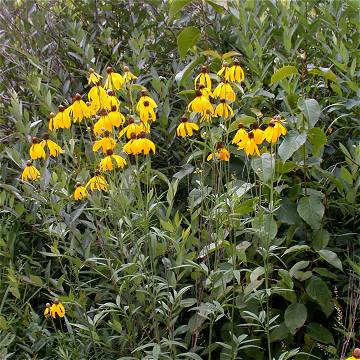

Ratibida pinnata - (image 1 of 7)
Taxonomy
Family: Asteraceae
Habitat
Dry prairies, field, woods. Degraded prairies. Often on calcareous soil.
Associates
Distribution
VT and MA, south to FL (absent from DE, MD, and NC), west SD to LA. Extirpated from PA.
Morphology
Herbaceous, rhizomatous perennial with fibrous roots. Leaves alternate, pinnatifid; lower leaves on long petioles; upper leaves on short petioles or sessile. Flower heads usually several; disk dark brown, globular, a little longer than wide; rays bright yellow, longer than the disk, typically reflexed. Achenes smooth, lacking puppus.
Notes
Flowers early July to late October
Wetland indicator: Upland
Also called Gray-headed Coneflower. The last three images aren't the best but I find the way the warbler blends with the coneflowers fascinating.
References
Gleason, Henry A. and A. Cronquist. 1991. Manual of Vascular Plants of Northeastern United States and Adjacent Canada. Second Ed.
The New York Botanical Garden. Bronx, NY
Swink, F. and G.
Wilhelm. 1994. Plants of the Chicago Region.
Indiana Academy of Science. The Morton Arboretum. Lisle, Illinois.
USDA, NRCS. 2002.
The PLANTS Database, Version 3.5 (http://plants.usda.gov).
National Plant Data Center, Baton Rouge, LA 70874-4490 USA.
|
Michael Hough © 2005 |